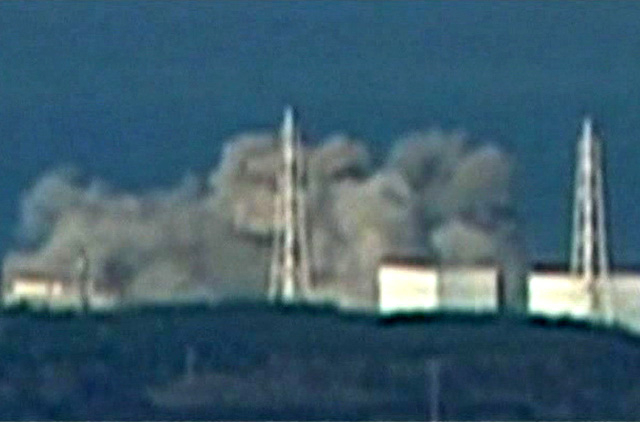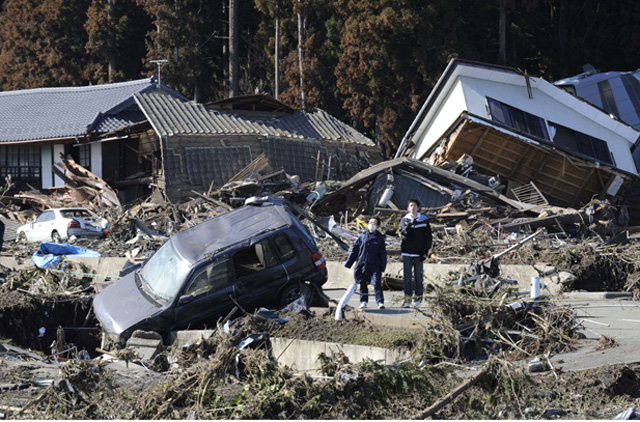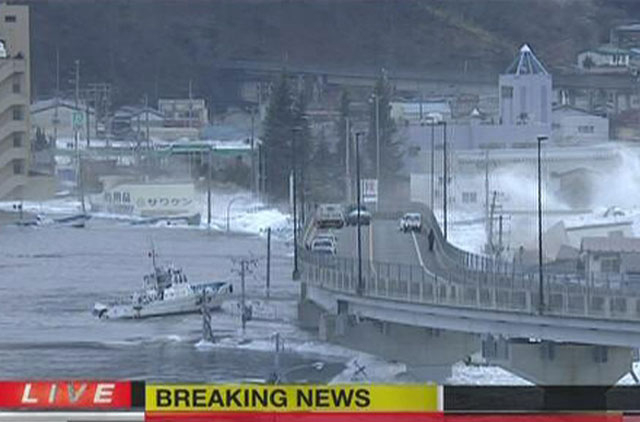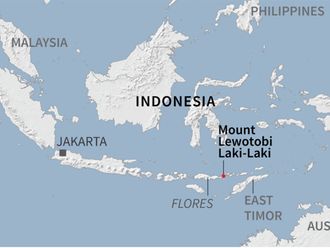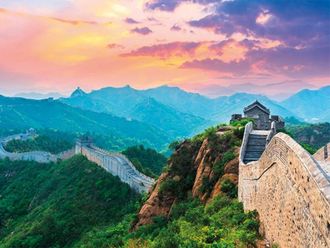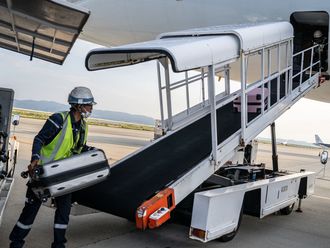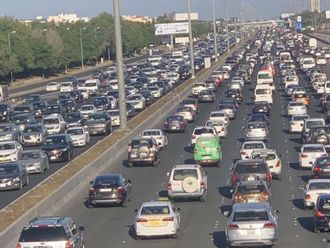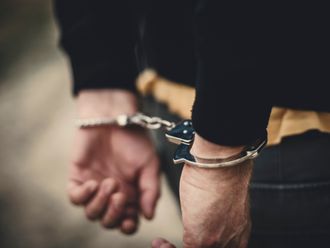
Fukushima, Japan: Around 10,000 people are unaccounted for in the Japanese port town of Minamisanriku in quake-hit Miyagi prefecture, public broadcaster NHK reported Saturday.
The figure is more than half of the population of about 17,000 in the town on the Pacific coast, Kyodo news reported.
Explosion heard at nuclear power plant
Earlier, an explosion heard and smoke was seen billowing at Tokyo Electric Power Company's Fukushima No 1 nuclear power plant, Jiji news agency quoted the police as saying on Saturday.
Japan earlier in the day warned of a meltdown at the nuclear reactor damaged when a massive earthquake and tsunami struck the northeast coast, but said the risk of radiation contamination was small.
The Kyodo News agency said earlier radioactive caesium had been detected near Fukushima No 1, about 250km northeast of Tokyo, citing the Japanese nuclear safety commission.
In pictures: 8.9 magnitude quake hits Japan
In pictures: Nature reigned supreme in 2010
Map: Major quakes around the world
The cooling system of the plant was damaged in the massive earthquake that struck the region 24 hours earlier, leaving authorities scrambling to fix the problem and evacuate more than 45,000 residents within a 10-kilometre radius.
Thousands were also evacuated from near a second plant, Fukushima No 2, which also suffered damage to its cooling system.
Parts of the No 1 reactor's nuclear fuel rods were briefly exposed to the air on Saturday after cooling water levels dropped and a fire engine was pumping water into the reactor, Jiji Press reported.
Russia on Saturday was closely monitoring radiation levels in its Far Eastern regions, officials said.
Test results have so far been normal and a tsunami alert for the Kuril Island chain has been cancelled, the emergencies ministry said on Saturday. "In connection with a radiation leak at a nuclear power station in Japan, control over background radiation in the Sakhalin region has been reinforced", the ministry said in a statement, adding that test results had been normal so far.
Background radiation levels were also being watched in the country's other Far Eastern regions such as Primorye, Kamchatka and Khabarovsk, ministry spokesman Sergei Viktorov said.
Earlier on Saturday, Japan scrambled to reduce pressure in two nuclear plants damaged after a massive earthquake and tsunami struck its northeast coast probably killing at least 1,300 people.
A day after the biggest quake on record in Japan, the government said it was still too early to grasp the full extent of damage or casualties. The confirmed death toll so far is almost 300, though media reports say it is at least 1,300.
"Unfortunately, we must be prepared for the number to rise greatly," Chief Cabinet Secretary Yukio Edano told reporters.
The tremor, with a magnitude of 8.9, was so huge that thousands fled their homes from coastlines around the Pacific Rim, as far away as North and South America, fearful of a tsunami.
Most appeared to have been spared anything more serious than some high waves, unlike Japan's northeast coastline which was hammered by a 10-metre high tsunami that turned houses and ships into floating debris as it surged into cities and villages, sweeping aside everything in its path.
"I thought I was going to die," said Wataru Fujimura, a 38-year-old sales representative in Koriyama, Fukushima, north of Tokyo and close to area worst hit by the quake. "Our furniture and shelves had all fallen over and there were cracks in the apartment building, so we spent the whole night in the car... Now we're back home trying to clean everything up."
Radiation leak
The government warned of a possible radiation leak as authorities began trying to reduce pressure at damaged two nuclear plants, sending tens of thousands of residents out of the area to avoid possible contamination.
Tokyo Electric Power Co (Tepco) said it had begun steps to release pressure at its two nuclear power plants in Fukushima, some 240 km north of Tokyo. But Kyodo news agency quoted the company as saying it was having difficulties opening a valve at its Daiichi reactor to release pressure.
Experts and the government both insisted there would be no radioactive disaster. "No Chernobyl is possible at a light water reactor. Loss of coolant means a temperature rise, but it also will stop the reaction," Naoto Sekimura, a professor at the University of Tokyo, said. "Even in the worst-case scenario, that would mean some radioactive leakage and equipment damage, but not an explosion. If venting is done carefully, there will be little leakage. Certainly not beyond the 3 km radius."
50 countires pledge help
The unfolding natural disaster, which has been followed by dozens of aftershocks, prompted offers of search and rescue help from 50 countries.
In one of the worst-hit residential areas, people buried under rubble could be heard calling out for rescue, Kyodo news agency reported. TV footage showed staff at one hospital waving banners with the words "FOOD" and "HELP" from a rooftop.
In Tokyo, tens of thousands of office workers were stranded overnight after the quake shut down public transport. Many were forced to bed down where they could, with newspapers to lie on and briefcases for pillows.
Kyodo said at least 116,000 people in Tokyo had been unable to return home on Friday evening due to transport disruption. The northeastern Japanese city of Kesennuma, with a population of 74,000, was hit by widespread fires and one-third of the city was under water, Jiji news agency said on Saturday.
The airport in the coastal city of Sendai, home to one million people, was on fire, it added. "Sendai [city] is now completely sunk underwater," said limousine driver Yoshikatsu Takayabe, 52. "What do I want the government to do? I can't flush the toilet, I want the water back on in my house."
TV footage from Friday showed a black torrent of water carrying cars and wrecked homes at high speed across farmland near Sendai, 300 km northeast of Tokyo. Ships had been flung onto a harbour wharf, where they lay helplessly. Kyodo news agency reported that contact had been lost with four trains in the coastal area.
The disaster poses a huge challenge for Kan's government which has come under such concerted attack from the opposition and within the ruling Democratic Party (DJP) that it has struggled to implement any policy. Just hours before the quake struck, Kan was rejecting demands that he resign, his political future looking increasingly bleak and unable even to muster enough support to ensure the passage of bills needed to enact the new budget.
But after the tremor, politicians pushed for an emergency budget to fund relief efforts, with Kan urging them to "save the country", Kyodo reported.
Japan is already the most heavily indebted major economy in the world, meaning any additional borrowing by the government would be closely scrutinised by financial markets.
Many fires
The quake, the most powerful since Japan started keeping records 140 years ago, sparked at least 80 fires in cities and towns along the coast, Kyodo said.
"When I felt the quake yesterday, I actually thought it was a strong wind slamming the door," said Emiko Nakahara, 61. "But then my husband said no, it's a quake. I was frightened like I've never been before."
Other nuclear power plants and oil refineries were shut down and one refinery was ablaze. Power to millions of homes and businesses was knocked out. Several airports, including Tokyo's Narita, were closed on Friday and rail services halted. All ports were shut.
Nuclear power plant operator Tepco warned of severe power shortages over the weekend. The central bank said it would cut short a two-day policy review scheduled for next week to one day on Monday and promised to do its utmost to ensure financial market stability.
The disaster struck as the world's third-largest economy had been showing signs of reviving from an economic contraction in the final quarter of last year. It raised the prospect of major disruptions for many key businesses and a massive repair bill running into tens of billions of dollars.
Fifth most powerful quake
The earthquake was the fifth most powerful to hit the world in the past century. It surpassed the Great Kanto quake of September 1, 1923, which had a magnitude of 7.9 and killed more than 140,000 people in the Tokyo area.
The 1995 Kobe quake caused $100 billion in damage and was the most expensive natural disaster in history.


